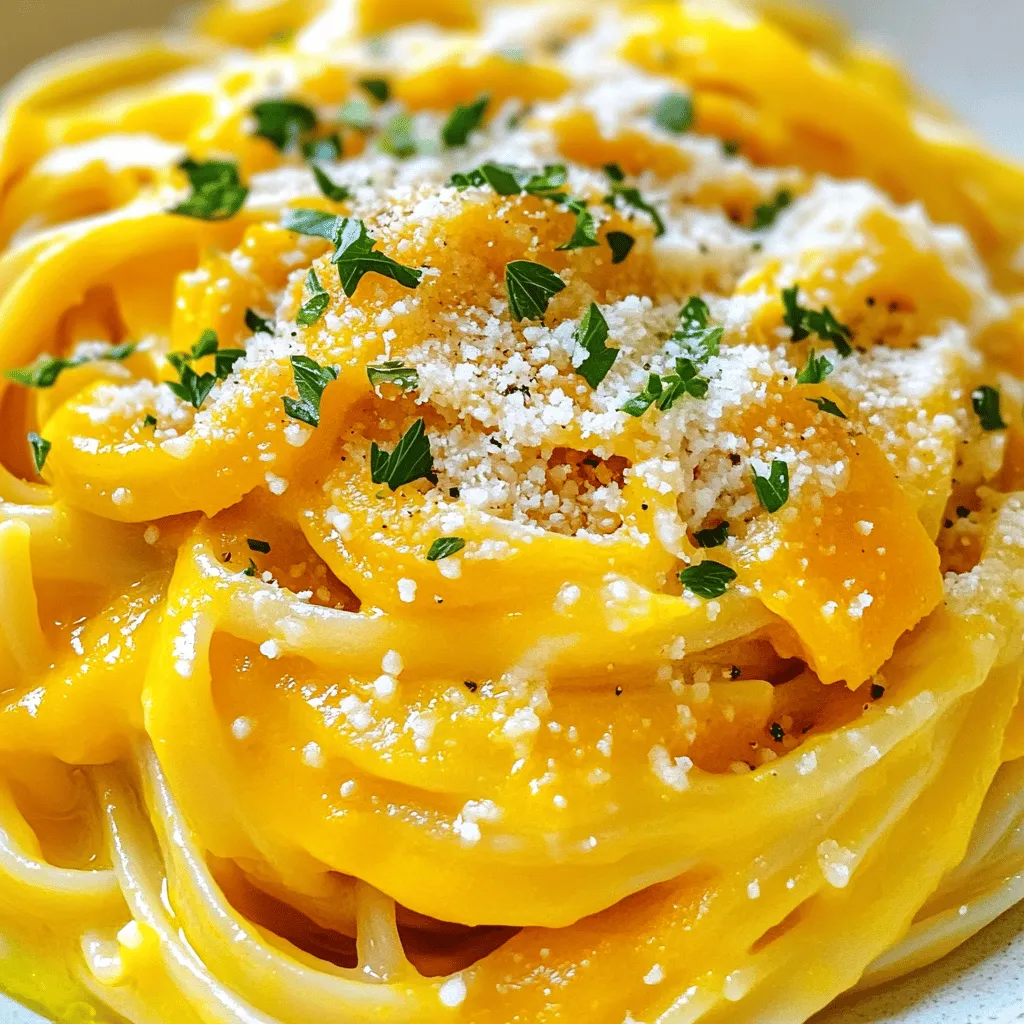Are you ready to transform your pasta nights? My Butternut Squash Pasta Sauce is smooth, rich, and bursting with flavor. Packed with nutrients, this dish isn’t just good for your taste buds; it’s good for your health too. Whether you’re a busy parent or a culinary novice, I’ll guide you step by step to create this delicious meal. Let’s dive into this vibrant sauce and discover why it’s a must-try!
Ingredients
Key Ingredients for Butternut Squash Pasta Sauce
To make a tasty butternut squash pasta sauce, you’ll need:
– 1 medium butternut squash, peeled and cut into 1-inch cubes
– 1 tablespoon extra virgin olive oil
– 1 small onion, finely chopped
– 2 garlic cloves, minced
– 1 teaspoon fresh sage, finely chopped (or ½ teaspoon dried sage)
– ½ teaspoon freshly ground nutmeg
– 1 cup vegetable broth (low sodium recommended)
– ½ cup heavy cream (or coconut cream for a dairy-free version)
– Salt and freshly cracked black pepper to taste
– ¼ cup freshly grated Parmesan cheese (optional)
– Fresh parsley, chopped, for garnish
– 12 oz of your favorite cooked pasta
These ingredients create a rich and creamy sauce. The butternut squash gives natural sweetness. The onion and garlic add depth and warmth. Fresh sage and nutmeg enhance the flavor, making it aromatic and inviting.
Optional Ingredients for Enhanced Flavor
You can add other ingredients to boost the taste:
– A pinch of red pepper flakes for heat
– 1 tablespoon of lemon juice for brightness
– Chopped spinach or kale for extra greens
– Toasted pine nuts or walnuts for crunch
These extras can personalize your sauce. They can create new layers of flavor and texture. Experimenting with these options can lead to delightful surprises.
Nutritional Benefits of Butternut Squash
Butternut squash is not just tasty; it has many health benefits:
– High in vitamins A and C, which support vision and skin health
– Rich in fiber, aiding digestion and keeping you full
– Contains antioxidants that help fight inflammation
– Low in calories, making it a great choice for weight management
Incorporating butternut squash into your meals adds nutrition. It’s a smart choice for a healthy diet. The creamy sauce is not only delicious but also nourishing. You can find the full recipe for this sauce in the Butternut Bliss Pasta Sauce section.
Step-by-Step Instructions
Preparation Steps for Butternut Squash
To start, you need to roast the butternut squash. First, preheat your oven to 400°F (200°C). Then, peel and cut the squash into 1-inch cubes. Place the cubes on a large baking sheet. Drizzle them with olive oil. Sprinkle with salt and pepper. Roast for about 25-30 minutes. Stir halfway through to ensure even cooking. The squash should be tender and lightly caramelized when done.
Cooking the Aromatics and Blending the Sauce
Next, it’s time to cook the aromatics. In a large skillet, heat 1 tablespoon of olive oil over medium heat. Add the finely chopped onion. Sauté for about 5 minutes until it becomes soft and translucent. Then, add minced garlic, fresh sage, and ground nutmeg. Stir them in and cook for about 1 minute. You’ll notice a wonderful aroma filling your kitchen! After the squash is roasted, add it to the skillet. Pour in the vegetable broth and bring it to a gentle simmer. Now, blend the sauce until smooth using an immersion blender. If you use a regular blender, transfer the mixture in batches carefully.
Combining Sauce with Pasta
Once the sauce is smooth, return it to the skillet. Stir in the heavy cream (or coconut cream) and Parmesan cheese if you’re using it. Let the sauce simmer on low heat for about 5 minutes. This helps the flavors mix well. Now, add your cooked pasta to the skillet. Gently toss until the pasta is well-coated in the sauce. If the sauce is too thick, add more vegetable broth until you reach your desired consistency. Enjoy every bite of your Butternut Bliss Pasta Sauce!
Tips & Tricks
Tips for Perfect Roasting of Butternut Squash
To get the best flavor from your butternut squash, roasting is key. Here are some tips:
– Cut Evenly: Make sure to cut the squash into 1-inch cubes. This helps them cook evenly.
– Preheat the Oven: Set your oven to 400°F (200°C) before you start. A hot oven gives a nice caramelization.
– Space Out the Cubes: Place the squash cubes in a single layer on the baking sheet. This prevents steaming.
– Use Enough Oil: Drizzle the cubes with enough olive oil. This helps them roast without drying out.
– Season Well: Sprinkle salt and pepper before roasting. This adds flavor right from the start.
Best Cooking Techniques for Creamy Sauce
Creating a creamy butternut squash sauce is simple with the right approach. Here are my top techniques:
– Sauté Aromatics First: Start by cooking onions and garlic. This builds a strong flavor base.
– Use an Immersion Blender: Blending directly in the skillet saves time and dishes. It also creates a smooth texture.
– Add Cream Gradually: Stir in the cream slowly while heating. This helps maintain a rich, creamy consistency.
– Simmer Gently: Let the sauce simmer on low heat. This melds all the flavors beautifully.
How to Achieve the Perfect Sauce Consistency
A thick sauce can be great, but sometimes you need it thinner. Here’s how to adjust the consistency:
– Add Broth Gradually: If the sauce is too thick, slowly add more vegetable broth until you reach your desired texture.
– Blend Well: Make sure to blend the sauce until smooth. This helps eliminate lumps that can affect texture.
– Test and Taste: After blending, always taste the sauce. This allows you to adjust seasoning and consistency to your liking.
For the full recipe, check out the Butternut Bliss Pasta Sauce. Enjoy your cooking!

Variations
Vegan and Dairy-Free Alternatives
You can easily make this sauce vegan. Swap heavy cream for coconut cream. It gives a rich taste without dairy. Use nutritional yeast instead of Parmesan cheese. This adds a cheesy flavor without animal products. You can also skip the cheese altogether for a lighter dish.
Adding Proteins and Vegetables
Boost the nutrition of your meal by adding proteins. Chickpeas or lentils work well. They mix nicely with the sauce and add a nice texture. You can also add cooked chicken or turkey if you prefer meat. For veggies, try spinach, kale, or roasted bell peppers. They add color and flavor.
Flavor Profile Changes with Different Herbs
Change the taste of your sauce by using different herbs. Thyme or rosemary can bring a warm flavor. Fresh basil adds a sweet touch. You can even try a bit of red pepper flakes for heat. Each herb will change the dish, so feel free to experiment.
Storage Info
Best Practices for Storing Leftovers
To keep your butternut squash pasta sauce fresh, store it in an airtight container. Make sure it cools to room temperature before sealing it. Store in the fridge for up to five days. If you notice any discoloration or off smells, it’s best to discard it.
Freezing Butternut Squash Pasta Sauce
You can freeze the sauce for later use. Pour the cooled sauce into freezer-safe bags or containers. Leave some space for expansion. It should last for about three months in the freezer. When ready to use, thaw it in the fridge overnight.
Reheating Instructions for Optimal Flavor
When it’s time to eat, reheat the sauce gently. Use a pan over low heat, stirring often. If the sauce seems too thick, add a splash of vegetable broth or water. This keeps the flavors fresh and smooth. Enjoy it warm with your favorite pasta!
FAQs
What types of pasta pair best with Butternut Squash Sauce?
You can use many types of pasta with butternut squash sauce. I like to use:
– Fettuccine
– Penne
– Rotini
– Bowtie
Each shape holds the sauce well, offering a great bite. Fettuccine’s flat shape lets the sauce cling beautifully. Penne’s tubes capture the sauce inside, while rotini’s twists add fun. Bowtie pasta adds a playful touch to your plate.
Can I make Butternut Squash Sauce ahead of time?
Yes, you can make butternut squash sauce ahead of time. It stores well in the fridge for up to four days. Just cool it down and place it in an airtight container. You can also freeze it for up to three months. When ready to use, thaw it overnight in the fridge. Reheat it gently on the stove, adding a splash of broth if needed.
How can I adjust the sauce’s sweetness or seasonings?
To adjust the sauce’s sweetness, you can add more or less butternut squash. For a sweeter taste, try adding a tiny bit of maple syrup or honey. For seasonings, I suggest starting with salt and pepper. Taste the sauce as you go. Add more nutmeg or sage if you want stronger flavors. This way, you can create the perfect balance for your meal.
To make butternut squash pasta sauce, we explored key ingredients and flavors. I shared step-by-step instructions for preparation and cooking. You learned tips for perfect roasting and achieving the right sauce texture. We also covered variations, storage options, and answered common questions.
Overall, this sauce is healthy and easy to make. It’s a great way to enjoy your meals. Try creating your own version and share it with others.

